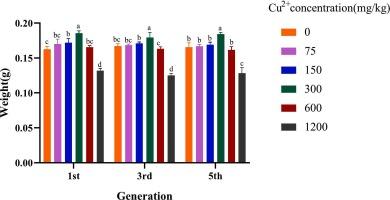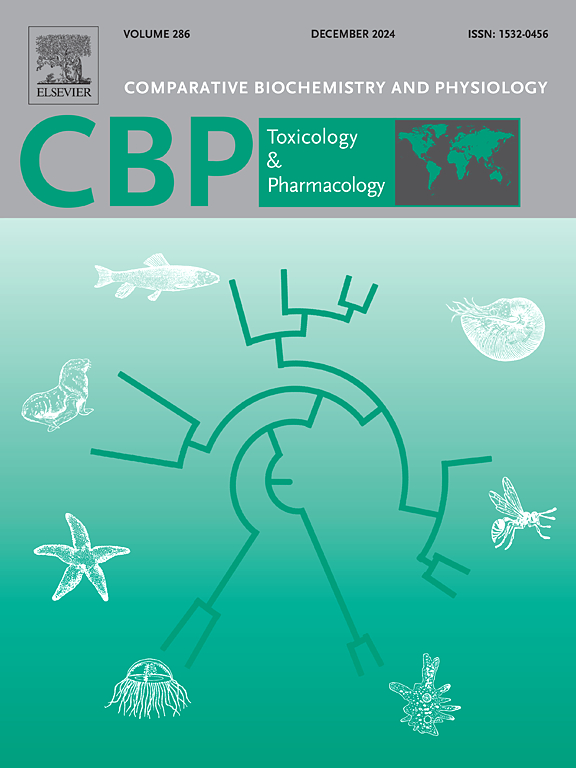Antioxidant response fail to rescue growth of Hermetia illucens L. larvae induced by copper accumulated during long-term exposure
IF 3.9
3区 环境科学与生态学
Q2 BIOCHEMISTRY & MOLECULAR BIOLOGY
Comparative Biochemistry and Physiology C-toxicology & Pharmacology
Pub Date : 2024-11-09
DOI:10.1016/j.cbpc.2024.110074
引用次数: 0
Abstract
Antioxidant indices and hemocytes apoptosis in the 6th instar larvae of Hermetia illucens., and their correlation with larval growth were evaluated by exposing larvae to different concentrations of Cu2+ for 1, 3 and 5 generations. Cu2+ accumulated in larval hemolymph showed significant dose-dependent relationship with Cu2+ concentrations in diets within a generation. Larval growth was only promoted after low concentrations of Cu2+ exposure for 1 generation, while seriously affected after high concentrations of Cu2+ exposure. Though total antioxidant capacity activity in larval hemolymph in treatment groups was all higher than that in control, it was increased at lower levels of Cu2+, while decreased with increasing Cu2+ concentrations at higher levels of Cu2+ exposure. The catalase (CAT) activity and metallothioneins (MTs) levels were also characterized as improved at lower levels of Cu2+, and inhibited at higher levels of Cu2+ exposure. However, CAT activity and MTs levels at higher Cu2+ treatments were significantly lower than that in control. Apoptosis rate of hemocytes was increased with increasing Cu2+ concentrations. Annexin V - fluorescein isothiocyanate (FITC)/ propidium iodide (PI) staining was in accordance with the results exhibited in flow cytometer. Results from transmission electron microscope and comet assay further confirmed that membrane blebbing, nuclear condensation, and DNA fragmentation were gradually apparent with increasing Cu2+ concentration. All parameters in different generation had similar dose-dependent trends, but the effects were strongest in the fifth generation. This study indicated that at some extent growth of H. illucens were associated with antioxidant responses and apoptosis induced by Cu2+.

抗氧化反应无法挽救长期暴露于铜积累诱导的Hermetia illucens L.幼虫的生长。
通过将幼虫暴露于不同浓度的Cu2+中1代、3代和5代,评估了Hermetia illucens.6龄幼虫的抗氧化指数和血淋巴细胞凋亡及其与幼虫生长的相关性。幼虫血淋巴中积累的 Cu2+ 与一代幼虫日粮中的 Cu2+ 浓度呈显著的剂量依赖关系。幼虫在低浓度 Cu2+ 暴露下仅能促进其生长 1 代,而在高浓度 Cu2+ 暴露下则会严重影响其生长。虽然处理组幼虫血淋巴中的总抗氧化能力活性均高于对照组,但在较低的 Cu2+ 浓度下,总抗氧化能力活性有所提高,而在较高的 Cu2+ 浓度下,总抗氧化能力活性随着 Cu2+ 浓度的增加而降低。过氧化氢酶(CAT)活性和金属硫蛋白(MTs)水平的特征也是在较低的 Cu2+ 水平下提高,而在较高的 Cu2+ 暴露水平下受到抑制。然而,CAT 活性和 MTs 水平在较高 Cu2+ 处理下明显低于对照组。血细胞凋亡率随着 Cu2+ 浓度的增加而增加。Annexin V - 异硫氰酸荧光素(FITC)/碘化丙啶(PI)染色与流式细胞仪显示的结果一致。透射电子显微镜和彗星试验的结果进一步证实,随着 Cu2+ 浓度的增加,膜破裂、核凝结和 DNA 断裂现象逐渐明显。不同世代的所有参数都有类似的剂量依赖趋势,但第五代的影响最强。这项研究表明,H. illucens 的生长在一定程度上与 Cu2+ 诱导的抗氧化反应和细胞凋亡有关。
本文章由计算机程序翻译,如有差异,请以英文原文为准。
求助全文
约1分钟内获得全文
求助全文
来源期刊
CiteScore
7.50
自引率
5.10%
发文量
206
审稿时长
30 days
期刊介绍:
Part C: Toxicology and Pharmacology. This journal is concerned with chemical and drug action at different levels of organization, biotransformation of xenobiotics, mechanisms of toxicity, including reactive oxygen species and carcinogenesis, endocrine disruptors, natural products chemistry, and signal transduction with a molecular approach to these fields.

 求助内容:
求助内容: 应助结果提醒方式:
应助结果提醒方式:


